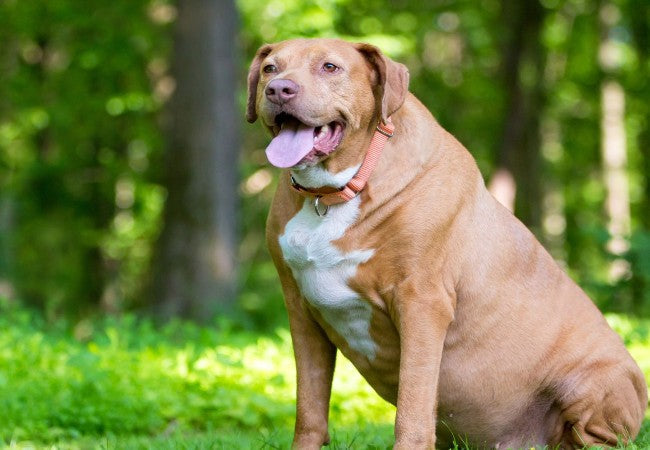Canine Obesity – Vet Guide 2025 🐶⚖️🩺

In this article
Canine Obesity – Vet Guide 2025 🐶⚖️🩺
By Dr. Duncan Houston BVSc
Hi, I’m Dr Duncan Houston, BVSc, founder of Ask A Vet. Obesity in dogs continues to be one of the most common—and preventable—health issues. With up to 59% of dogs overweight, obesity impacts longevity, joint health, metabolism, and everyday wellbeing. This 2025 guide demystifies canine obesity: why it happens, how to spot it, measure it, treat it safely, and support your dog long-term through diet, exercise, and emerging therapies. Your dog deserves a healthier, happier future! 🌿
📚 What Is Canine Obesity?
Obesity means a dog carries excess fat—typically defined as ≥20% over ideal weight—and is associated with serious metabolic and health consequences . It’s the most frequent nutritional disorder affecting dogs today .
🏥 Why Obesity Matters – Health Impacts
- Reduced life expectancy—obese dogs live ~2 years less .
- Joint disease & osteoarthritis—extra weight worsens pain and mobility .
- Higher risk of diabetes, hypertension, heart disease, respiratory issues, cancer .
- Lower energy, less playfulness, and increased surgical and anesthesia risks .
📌 Why Dogs Gain Weight
- Calorie imbalance: too much food, too little exercise—especially common in middle-aged indoor dogs .
- Owner habits: overweight owners, frequent treats, and sharing human food .
- Breed & age: Labradors, Beagles, Dachshunds; decline in metabolism after age 5 .
- Medical conditions: hypothyroidism, Cushing’s disease, insulinoma, some medications .
- Spay/neuter effects: lower metabolic rate and appetite changes .
🔍 Diagnosing Obesity
- Body Condition Score (BCS): 5-point or 9-point scale—score ≥7/9 signals obesity .
- Physical signs: no waisttan, ribs not palpable, abdominal sagging .
- Weight trends: monitor gain over time, using scales and record‑keeping .
- Lab & diagnostic screens: blood tests for thyroid, cortisol; abdominal imaging if sudden weight gain .
🚀 Safe Weight Loss Strategy
The goal: ~1–2% body weight loss per week (monthly target 3–8%) is safe and effective .
- Treat underlying disease: bloodwork and medical treatment for thyroid, Cushing’s, etc.
- Calculate Daily Energy Requirement (DER): based on ideal weight and activity level .
- Feed therapeutic diet: high‑protein, high‑fiber, calorie‑restricted formulas .
- Portion control: weigh meals precisely; no free-feeding; measured treats only for training .
- Add healthy fillers: green beans, pumpkin, or water to bulk up volume .
- Increase exercise: start with 15–30 min daily walks; adjust gradually based on fitness .
- Track progress: weigh monthly; adjust plan if no change by 4–8 weeks .
💊 Supplements & Future Medications
Weight‑management supplements like fiber‑rich blends support satiety and metabolism under vet guidance . Additionally, Ozempic-style drugs are undergoing trials—an appetite-regulator helped cats with 5% weight loss in 4 months, and similar canine meds may arrive soon .
🧘 Lifestyle & Home Support Tips
- Clean-feeder tools: slow-feeder bowls prevent overeating.
- Rotate treats: fresh veggies as low-calorie rewards .
- Exercise variety: swimming or agility work to boost activity without strain .
- Family commitment: ensure all members follow plan—no sneaky snacks .
- Comfort aids: padded beds, elevated bowls support joint‑compromised pups .
- Regular vet check-ins: every 4–8 weeks initially, then quarterly .
📅 Monitoring & Adjustments
- Monthly weigh-ins: adjust food ±10% every few weeks based on trends.
- BCS evaluations: involve vet or tech to track visual/physical changes.
- Health rechecks: lab tests every 3–6 months to monitor metabolic improvements.
- Goal planning: once ideal achieved, transition to maintenance diet and routine exercise .
🔎 Summary – Key Facts
- Obesity affects nearly 60% of dogs and shortens lifespan—but it’s reversible and preventable.
- A healthy weight improves joints, heart, breathing, mobility, mood, and lowers disease risk.
- Safe weight loss = slow, steady, multi-pronged approach: diet, exercise, monitoring.
- Supplement strategies and new medications show promise—stay tuned.
- Success depends on consistency from the whole household and professional oversight.
🐾 Ask A Vet, Woopf & Purrz Support
- Connect with a veterinary nutritionist via Ask A Vet to personalize weight loss strategy.
- Explore weight‑support feeding tools, slow‑feed bowls, and healthy treat alternatives through Woopf.
- Support joint comfort with plush beds, padded ramps, and enriching toys from Purrz.
Ready to help your dog slim down, feel better, and live longer? Start today with your vet’s guidance or reach out to Ask A Vet. Together, we’ll set them on a path to lifelong wellness. 🐶❤️






